Reaching The Galleria Not Easy For Pedestrians
In May 1988 a small mall in the St. Louis suburb of Richmond Heights began planning to expand, from the St. Louis Post-Dispatch on May 15, 1988:
“Earlier this month, Hycel Properties Co. announced an ambitious plan to quadruple the size of the Saint Louis Galleria. The Richmond Heights shopping mall will add four department stores, 100 new specialty stores, a 300-room luxury hotel, two covered parking garages and up to three office buildings.”
At the time both sides of Brentwood Blvd was lined with buildings. Â The developer needed help from the Richmond Heights:
“The St. Louis Galleria said Monday that it would seek eminent domain power from the city of Richmond Heights to acquire 94 of the 113 commercial buildings and houses in the Clay North neighborhood.” – P-D Aug 30 1988
Richmond Heights granted the power of eminent domain but did nothing to ensure pedestrians could also reach the expanded Galleria. Â The mall has five entrances to the outdoors and a few more connecting to the parking garage along the west side of the mall. The expansion was built in the early 1990s, after the Americans with Disabilities Act of 1990 became law.
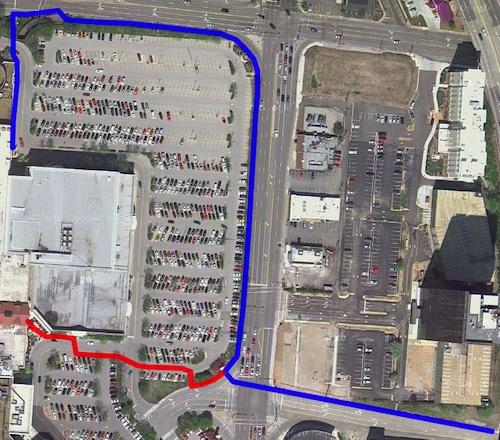
The expanded Galleria would be open for nearly 15 years before the MetroLink light rail line would open nearby but since the mall is surrounded by housing & businesses they should have planned for customers to arrive on foot rather than behind the wheel. In a minimal way, they did but I’ll get to that in a bit.
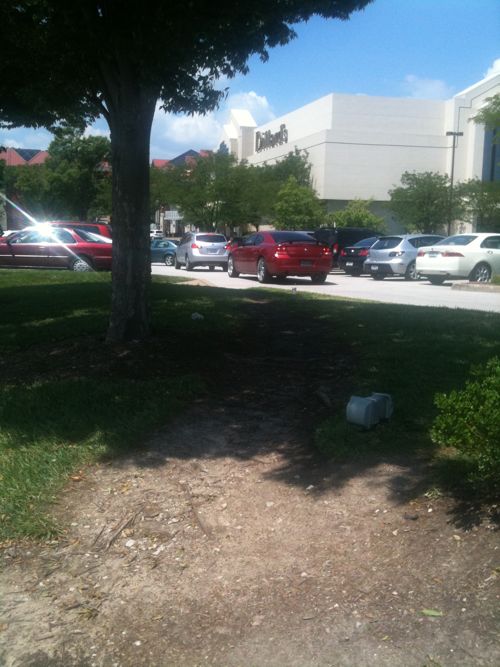
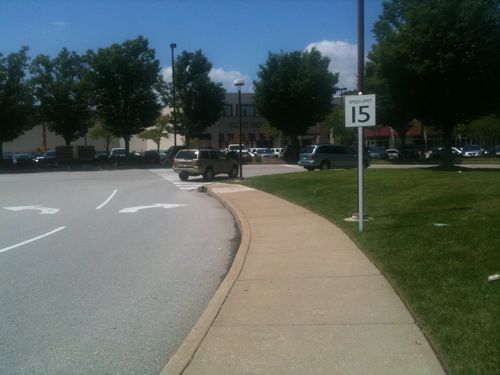
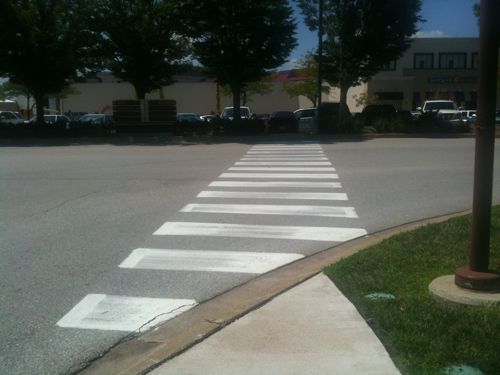
I did “drive” my wheelchair through the parking lot to reach the nearest entrance – once. On my next visit I followed the perimeter sidewalk trying to access an entrance without risking my life wheeling through the parking lot.
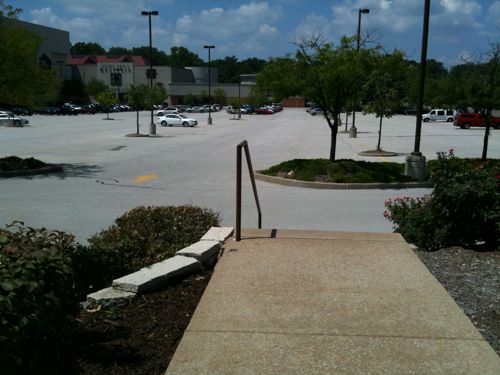
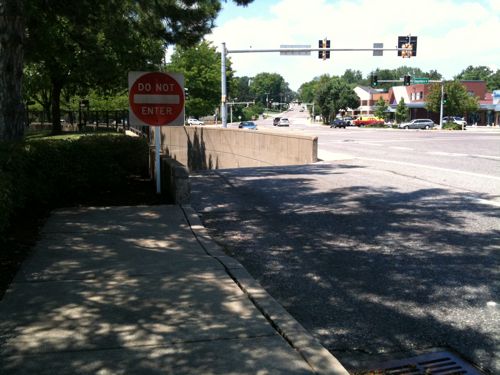
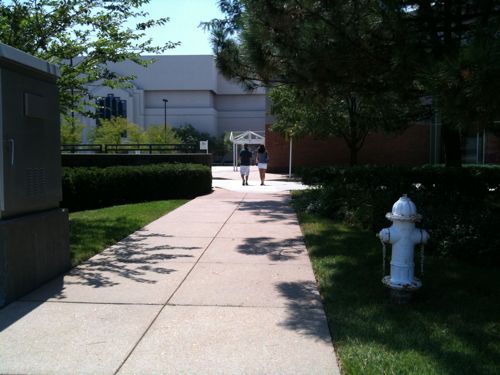
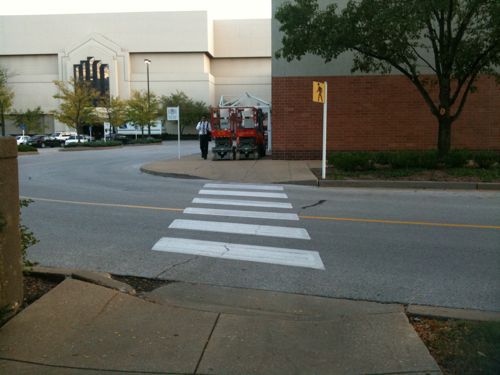
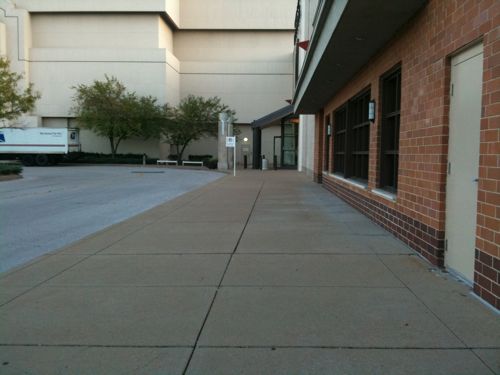
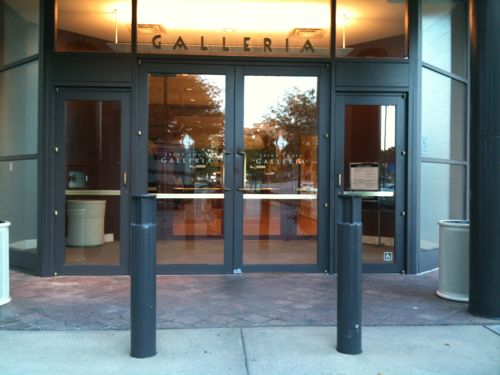
That’s right, the other four entrances have sliding door that open automatically but this entry has standard doors! The door on the right has a wheelchair sticker at the bottom but no opener so I don’t get why. Â But I was able to get past the doors and the set of doors right behind but it involved considerably more work than wide sliding doors.
On my next visit I will see if I can go around the former Mark Shale space to reach the entry by Restoration Hardware. A lot of work to reach the mall, someone working at the office building just across I-64 would never travel this far on foot to the mall on their lunch break or after work. Â Nor would they walk through the parking lot from the public sidewalk along Brentwood. Â The Galleria at Clayton & Brentwood could have easily been designed with pedestrian routes to five entrances. Â Very little effort, very little cost — but lasting benefits.
– Steve Patterson
I also like how some of the bus stops on the Galleria side of Brentwood have ramps into the parking lot, but no sidewalk connection to the nearby department stores.
I believe Ann & Taylor has an accessible entrance on the back side of the mall past Restoration Hardware, but it's been a while since I've looked. Also, don't try the Brentwood entrance closest to I-64 as it's just as bad as the Galleria Pkwy entrance.
Note, the ADA became law in 1990 but did not take effect until 1992, one year after the expanded Galleria opened in 1991. Of course, the ADA did not include a grandfather clause, so the Galleria is still mostly non-compliant.
Here's a
There's a solution that could make the walk more comfortable, plus make money for the mall. That is, build a lifestyle outdoor shopping area from the direct entrance out to Brentwood Boulevard.
From your aerial, it looks like less than 50 spaces would be displaced. Still, it looks like over 200 spaces sit empty at the corner of Clayton Road.
Basically agree, on the reality and the results. Vehicular access and circulation ain't great, either, but is typical of many older malls, that have expanded incrementally, over decades. While the legal, PC thing to do would be to fully comply with every nuance of the ADAAG, every thing has a cost/benefit tradeoff. Are disabled customers staying away, because they can't walk from Metrolink? Or, are they driving and parking, like the vast majority of all the other customers? This is crass, but does being a pedestrian (of any sort, able bodied or disabled) come with the assumption that you also have (way?) less money to spend?! This is a shopping mall, after all, complete with a curfew for teenagers who come to hang out, but not to spend money.
Realistically, the best way to achieve compliance is to hold Nordstrom accountable, as they complete the new store they currently have under construction. There's no valid reason for them not to provide an accessible path of travel from the transit stops on Brentwood Boulevard, and if they do, most of your accessibility issues will be addressed.
http://www.nytimes.com/2010/10/11/technology/11interior.html?th&emc=th
I included pedestrians in the title for a reason. The able-bodied living or working nearby should want to walk there, it should be pleasurable to do so. Parents pushing baby strollers need the same route I need. The basics of walkability existed long before the ADA.
While I agree that if it's not walkable, only the most dedicated will attempt to walk, I disagree that the “able-bodied living or working nearby should want to walk there”. Most people who live next to large retail centers view them as negatives, akin to freeways or airports, not positives. And while wokers may be inclined to walk and shop over their lunch hour, your vision of retail seems to be stuck in an archaic, quaint, romanticized vision that no longer really exists.
Even 20 years ago, a typical lunchtime shopper for many of the establishments in the mall would be female, doing recreational shopping, for things like clothing and shoes. Today, that shopper would more likely be found in their cubicle, online, at Zappos.com, eating yogurt and drinking a Diet Coke.
You're a single male who embraces urbanism and walkability. The typical retail shopper is female, married and, usually, working. Shopping is not about recreation, it's about buying efficiently. They don't have either the time or the inclination to a) walk, b) stop by every day after work to pick up a few things for dinner, or c) take their purchases home using public transit! The Walmarts and the Schnucks are thriving because they meet that need. They have the food, the cosmetics, the pharmacy, the diapers, the clothes and the paper goods, all under one roof, at attractive prices.
Along the continuum of encouraging walkability, the regional shopping mall or big box store is so far removed from reality that efforts are better spent elsewhere. We need to make workplaces and the retail supporting workers (lunchtime dining options, media retailers, card shops, etc.) more pedestrian friendly. Few people are going to buy that 64-roll package of toilet paper over their lunch hour; they're going to wait until their weekend and buy it on that $200 stock-up trip, when they can drive.
We need to make neighborhoods walkable and get back to neighborhood schools. We need to make transit more attractive to daily commuters; it's simply not very relevent to most shopping trips for most customers. And we need to accept that the car is not evil – used sparingly, it can really enhance our lives.
Great post Steve! Think you could compare this to some other malls around STL? I think Chesterfield Mall deserves some specially ADA related scrutiny…
Other malls like Chesterfield are not surrounded by businesses and residences the way the Galleria is. I have higher expectations for development in areas where pedestrians can reasonably be anticipated.
Huh? Crestwood Court, West County, South County and Chesterfield Malls are all surrounded by businesses, office buildings and residences, both single-family and multi-family. Where they differ from the Galleria is that none of them are near Metrolink. I, too, “have higher expectations for development in areas where pedestrians can reasonably be anticipated.” I guess I just don't expect the residents or workers in Richmond Heights or Clayton to be any more inclined to walk any further than the parking lot than residents or workers in Chesterfield, Des Peres or Crestwood.
The other are not in corn fields but they are also not in areas with lots of public sidewalks. How can these developments be expected to have walkable/accessible routes when the municipalities don't provide sidewalks along the roads? But each of these other malls are served by transit, taking the bus to each would be interesting.